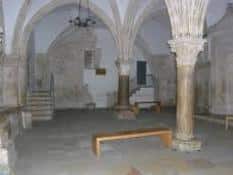Before proceeding to determine the meaning of the term at hand, we must know its etymological origin. Specifically, we can establish that it derives from Latin, specifically from the word “cenaculum”, which can be translated as “dining room”.
The idea of cenacle alludes to the place where the last supper shared by Jesus Christ and his disciples took place. It is a space located in the city of Jerusalem , where the apostles continued to meet after the resurrection of Christ according to Christian beliefs.
 At the time of Jesus Christ , the cenacle in question was a two-story building, owned by one of his friends. The ground floor was used for prayer , while eating was done on the upper floor.
At the time of Jesus Christ , the cenacle in question was a two-story building, owned by one of his friends. The ground floor was used for prayer , while eating was done on the upper floor.
This cenacle became an important meeting point for Christians. Over time, a church was built on the site, also with two floors. The lower sector, known as “David's Tomb” , is a site of veneration for Christians, Muslims and Jews. The upper floor room is specifically known as the Cenacle .
Other interesting facts about this cenacle are the following:
-It is considered that this room was part of a house that belonged to a friend of Jesus.
-It also responds to the name of the upper room.
-There are several paintings that, over the centuries, have attempted to represent that cenacle that hosted Jesus' last supper. However, perhaps one of the best known is the one titled “The Last Supper.” It is a mural type and was made between 1495 and 1498 by the great artist Leonardo Da Vinci. It is a painting that is declared a World Heritage Site and is currently in the refectory of the Dominican convent of Santa Maria delle Grazie, in Milan. It measures about 880 centimeters wide and about 460 centimeters high.
-Currently, Muslim worship is prohibited in the aforementioned cenacle. What's more, the Israeli authorities have declared it the synagogue of David's tomb.
Beyond the specific place where the Last Supper of Jesus Christ took place, in Roman times the room in a house where the family gathered to eat was called the cenacle. The cenacle, in this sense, was an informal dining room , usually located on the upper floor. It was also sometimes used as slave quarters. On the ground floor, however, visitors were received and various meetings were held, including formal meals.
The second meaning of the concept mentioned in the dictionary of the Royal Spanish Academy ( RAE ) refers to a meeting in which few individuals participate, who come together for professional, ideological or other reasons. For example: “I have no intention of liking the members of the cenacle” , “Someday the investigations of the cenacle will come to light” , “The cenacle that governs this country will never think about the people” .
In addition to all the above, we can emphasize that within the field of literature the term in question has been used on more than one occasion to title different works. An example of these is “The Cenacle of Blood”, written by Jesús Paguillo Palacios.
